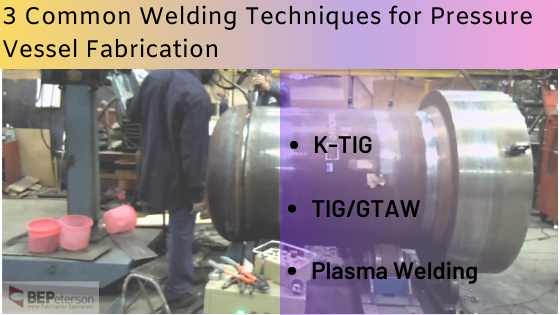Pressure vessels are the answer when it comes to solve your challenges pertaining to the storage and transfer of gas or liquid under high pressure. Available in several types, sizes, shapes and specifications, they are largely utilized by varied industries for high-pressure or low-pressure containment. Considering the critical nature of the applications, these tanks are fabricated through several steps by paying utmost attention to minute details. What are the processes involved in pressure vessel or tank fabrication? The processes are many including forming, pressing, spinning, bending, welding, post weld heat treatment, assembly and painting. Although each of these processes contribute to the successful pressure vessel or tank fabrication, welding is one of the most critical steps, which must be performed by experienced qualified welders. What are the commonly utilized welding techniques in pressure vessels fabrication? Read the post to know more!

3 Common Welding Techniques Employed in Pressure Vessel Fabrication
Welding is a common process in all kinds of metal fabrication, wherein the pieces are joined by means of heat or pressure or both. Several types of welding processes are employed in pressure vessel fabrication, which are as follow:
- TIG/GTAW: This is a versatile, all-position welding process, which typically utilize a non-consumable tungsten electrode to make the weld. It provides the highest quality weld and hence has become highly attractive replacement for gas and manual metal arc welding in pressure vessel fabrication. TIG welding is mostly used where precise, small welds are needed on stainless steel and non-ferrous metals such as aluminum, magnesium, and copper alloys.
- Plasma Welding: Plasma arc welding is a widely utilized welding process in pressure vessel fabrication wherein plasma, which is heated to an extremely high temperature and ionized, is used to transfer an electric arc to a work piece. The plasma welding process brings the highest quality standards to pressure vessel fabrication and it helps make strong and precision welds on both thick and thin metal. The method provides advanced level of control and accuracy to produce high quality welds at extremely high speed compared to other welding processes.
- K-TIG: K-TIG is a single-pass, full-penetration keyhole welding performed on stainless steel, as well as titanium, zirconium, and nickel during pressure vessel or tank fabrication. The technology offers enormous productivity, cost, and quality advantages, whilst also assuring x-ray quality welds with superb cap and root aesthetics. Keyhole TIG (K-TIG) welding is a revolutionary technology that guarantees low level of weld seam crowning and low distortion, no slag or spatter, and low energy requirement, among others.
When it comes to pressure vessel fabrication, quality must be stringently taken care of at every step of the production. Welding, being one of the critical processes, is of no different to it. Any flaw in the welding will have disastrous consequences when the vessel is put in operation. Not only welding, all the other processes of vessel fabrication mentioned earlier must be executed with utmost precision. This is exactly why you must consider partner with a certified pressure vessel manufacture like BEPeterson. Being an ISO 9001:2015 certified and ASME certified manufacturer, the company ensures the fabrication in conformance to all safety guidelines and quality standards.
